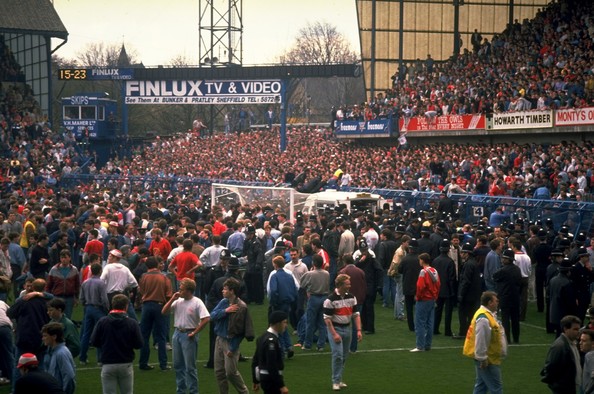Monday Milestone: Hillsborough
This Week in History:
1989, April 15
Ninety-six people are crushed to death with poor crowd control, as too many fans fill the stadium at Hillsborough in Sheffield for the FA Cup semi-final between Nottingham Forrest and Liverpool.
“The numbers of dead rose by the minute – seven, then a score, then fifty-something
and eventually ninety-six – and you realised that if anyone had even a shred
of common sense left available to them, nothing would ever be the same again”
Nick Hornby, Fever Pitch
They came in through the turnstiles by their thousands.
There were so many Liverpool fans. They streamed in from the Leppings Lane end of the Hillsborough Stadium for the FA Cup semi-final with Nottingham Forrest. These were the days before electronic ticketing and allocated seating. This was the era of terraces with ‘standing room only’, when safety was simply an afterthought, and grounds would cram as many fans in as they could. And despite the constant recurring concerns over previous years about overcrowding the threat was not considered a cause for alarm…
On this particular afternoon in Sheffield, some 24,000 Liverpool fans were already streaming into the ground for the 3pm kick off, into their segregated terraces; a concept that divided the stadium into individual supporter groups, thought to be imperative to prevent violent clashes between fans. But unfortunately the infrastructure of the Hillsborough Stadium was somewhat lacking. Only 23 turnstiles serviced these fans; nowhere near enough for the droves of eager fans that continued to pile up around outside the stadium, hoping to enter.
By 2:40pm the Liverpool pens were already well and truly full. Yet still their fans kept coming. The congestion was intense, and bottlenecks developed. Inside the stadium, hundreds of spectators were already pressed up against the high steel fencing (that had ironically been placed around grounds in that era as a safety measure). Yet outside the stadium, still fans continued to enter the allocated terraces for Liverpool fans without any knowledge of the danger they were creating.
Hindsight tells us, tragedy was imminent. Already experiencing poor crowd control from police, when Chief Superintendent Duckenfield, threw open Gate C, an exit gate which opened a tunnel leading directly to two pens that were already dangerously full of Liverpool supporters to ease the overcrowding outside, and another wave of a fans streamed in, that was the catalyst for disaster. Whilst he would later lie about it when questioned, and declare that he was powerless as the supporters had instead rushed the gate, it was the critical error.
And it was the moment that turned a tightly pressed situation, into a tragic one. As more fans piled in, the desperation among those pressed up against the fences mounted. Panic set in. Fans began climbing the high steel fences to escape. It wasn’t until they began spilling onto the track near the field, at approximately 3:06pm, the match stopped. Officials suddenly recognised these people were scrambling for their lives.
But by then it was too late. Ambulances had not been able to access the areas, and the wounded were blocked from being carried out, as one by one, these supporters of all ages began to suffocate of compressive asphyxia. Many would never escape with their lives. Panicking families were attempting to resuscitate dozens of people. The scenes were tumultuous, chaotic, and heartbreaking…
Football has changed. We may live in a world today that many consider overly cautious and overzealous when it comes to occupational health and safety. But it is catastrophic events like Hillsborough that continue to remind us why.
Milestone Five: Worst football disasters at stadiums
5. Ibrox Stadium, Glasgow, Sctoland, 1971 – During the final minutes of a match, it is thought someone fell on the staircase whilst exiting, resulting in a chain reaction and a pile-up of bodies. 66 Rangers fans were killed.
4. Estadio Nacional, Lima, Peru, 1964 – Riots at a Peru v Argentina match results in tear gas being deployed, chaos, and crushes. Over three hundred people died.
3. Valley Parade, Bradford, England, 1985 – Fire engulfed a stand during a third division match resulting in the death of 56 fans with a further 265 or more injured.
2. Heysel Stadium, Brussels, Belgium, 1985 – During the European Cup match between Juventus and Liverpool. 39 people were crushed to death, and England were banned for five years from European competition.
1. Hillsborough, Sheffield, England, 1989 – Ninety-six people were killed when shocking police control fails to alleviate the congestion and supporters are trapped up against steel fences and crushed to death.
With thanks to Getty Images Europe for the picture

